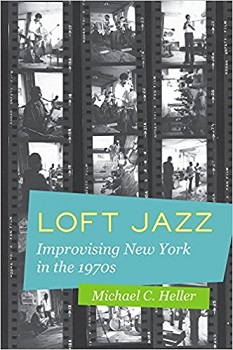MICHAEL C. HELLER

Loft jazz lives
interview by Daniel Barbiero
(August 2017)
In the late 1960's and into the 1970's, many of Lower Manhattan's disused factories and warehouses were converted into living spaces and performance venues. During this period, some of the most innovative and exploratory players to come out of the jazz tradition lived and played in the lofts that were carved out of those spaces, in the process creating a center of activity that came to be known as the loft jazz scene. Essentially over by 1979, by the mid-1980's, the scene had been largely overlooked or dismissed by the neotraditionalist accounts of jazz history that were then ascendant. Michael C. Heller, an ethnomusicologist and historian of music at the University of Pittsburgh, tells the story of Lower Manhattan's avant-garde jazz community in his book Loft Jazz: Improvising New York in the 1970s. Largely a social history, Heller's book is based on extensive research, including invaluable interviews with many of the surviving participants; their first-person accounts provide vivid, and sometimes surprising, perspectives on what to many of us was a legendary time. Michael and I conversed by email to talk about the background to the book, and about some of the ideas that were in play among New York's creative musicians at the time.
PSF: I came of age musically in the mid-1970's. I remember vividly the excitement artists like Sam Rivers were generating at the time--the college radio stations I listened to played him a lot and were very enthusiastic not only about what he was doing with his trio and with Studio Rivbea, but about the other artists involved with what came to be called the loft jazz scene. And yet after a few years--starting sometime in the 1980's it seems--these artists and the scene they were part of were largely forgotten or ignored in the more broadly disseminated jazz narratives.
MH: You're absolutely right that a lot of what happened in the lofts got left out of subsequent jazz histories. I'm actually a bit younger than you, coming up mostly in the 1990's (sadly, I missed the loft scene, myself). I got very interested in jazz history as a teenager and read a ton of books, but they had practically NOTHING about the lofts. I had barely heard of them until I lived in New York in the early 2000's, where I was working for WKCR and at the Vision Festival. As a history junkie, I was suddenly surrounded by musicians like William Parker and Roy Campbell, and they were talking about how vibrant the New York scene was in the 1970s. So there was this weird disjuncture: incredible artists were telling me about how the loft years were this amazing period, but the history books had absolutely nothing to say about it. That's one of the things that inspired me to write the book.
When I went back and looked at the way the lofts were written about in the '70's and '80's, certain reasons for this became clear (I talk about this a bit in the conclusion of the book). Early on, in the loft period, they were talked about with a lot of revolutionary optimism. They were seen as providing a way of bypassing commercial venues and re-taking control over one's art. But by the '80's, some musicians became a bit disillusioned with it. They saw lofts as just providing low quality gigs, with lousy sound, poor planning, no publicity, and musicians playing for meager door money. Even when they were talked about positively, they were sometimes framed as a kind of stepping-stone to bigger, better paying gigs (in Europe, or at newer venues like Joe's Pub). This was very different from how the spaces were initially envisioned. They were supposed to provide a degree of self-determination by circumventing other presenters, not as a way to get your foot in the door with them. But it's true that things often didn't work out the way that the presenters hoped (and different presenters sometimes had very different goals, as well). I think these perceptions might have contributed to what you mention about them being ignored in the 1980's. For some, they seemed like a failed experiment. It wasn't really until the 1990's with organizations like the Improvisors Collective and the Vision Festival that they started to be written about more fondly again.
In the book, I try to give space to both sides - both musicians who believed in the loft enterprise and those who didn't. I probably represent the former a bit more, just because most of the musicians I was working with were involved in running loft spaces. Plus, I think it's important to document the revolutionary intent that inspired many of the earliest lofts, which was tied in closely with the musical, social, political, and geographical environment of early 1970's New York.
PSF: In the environment of the early 1970's--not only in New York, but seemingly everywhere else--the idea of freedom was in the air. Particularly for artists: one created art to be free, one created art free of conventions. Freedom is one of the ideas you explore in your book, but as you show, it was a polysemous idea--an idea that could mean many different things to many different people.
MH: That's absolutely right, which is why I devote a whole chapter to freedom in the book. It came up a lot in my conversations with artists, but people used it in different ways. Sometimes it referred to economic freedom: having control of your art and being able to profit from it. Sometimes it meant artistic freedom: freedom from constraints of genre, of following a set of pre-defined chord changes, etc. And sometimes it meant a sort of spiritual freedom: freedom to transcend earthly concerns and reach a sort of ecstatic ethereal state. These aren't mutually exclusive (many artists combined a few of them), but they're not exactly the same thing either. So one of the things the book does is to try to parse out several definitions.
One particular distinction I draw is between ideas of freedom that I refer to as 'collectivism' and. 'communalism.' 'Collectivism' refers to various forms of organization-building in groups like the AACM and BAG. The central premise is that by developing a strong organizational structure, a devoted and disciplined membership, and a clear set of goals and strategies, musicians could reclaim control over their work and free themselves from the constraints of the commercial market. These approaches were heavily influenced by community organizing strategies coming out of the Civil Rights and Black Power movements. 'Communalism,' on the other hand, was more of an ideal emerging out of the '60's counterculture (Woodstock, Timothy Leary, etc.). Communalist ideals were more about forming open, egalitarian communities, free from any hierarchies or distinctions between members. In the parlance of the time, it was about "dropping out" of society, and forming your own local communities based on openness, sharing economies, and trust.
What's interesting about the lofts is that it sat right at the intersection of these two approaches. There were a lot of movements in the lofts that aimed towards specific, intentional organization building and activism. But there were also a lot of lofts that were just open spaces where people could come to talk, play music, share resources, and be together. My goal in discussing them wasn't so much to pit one against the other. But I do think that understanding what was happening in the loft era requires thinking about both of these influences.
PSF: In contrast to experimental or avant-garde artists working in the tradition of Western art music, free jazz artists for the most part weren't accepted as a legitimate avant-garde. Around the mid- to late-1970's this seems to have changed, and I wonder to what extent that might've been because of what New York's creative musicians were doing at the time.
MH: It sort of depends on what you mean by "accepted." George Lewis writes brilliantly (in his piece "Experimental Music in Black and White") about the way that black avant garde traditions were discussed in the press of this period. While it's true that there were enormous successes and movements toward increased openness and boundary-blurring, there were also some disturbing instances of gatekeeping, of trying to limit black artists to being discussed in the context of "jazz," and cultivating an image of "Downtown" that too-often erased the presence of black contributors, even while drawing predominantly from African American aesthetic streams. So while there were triumphs, there were also a lot of battles, which are still being fought in a lot of places. I probably don't have too much I can add to Lewis' analysis on that front.
I could note, though, that a lot of loft artists did gain more recognition in Europe at the time. The European Festival circuit was absolutely crucial for a lot of musicians at the time. It was incredibly difficult to make any significant money in loft performances, but the better funded European festivals paid much better, and were more appreciative of the jazz avant garde. In 1976, the Berliner Jazztage festival even had a loft theme that carried through the event, inviting New York-based artists like Sam Rivers and Kalaparusha Maurice McIntyre. This pattern of European festivals being more receptive and more equitable in their payments is, of course, one that still continues, and which musicians often talk about.
PSF: Your book is illuminating for revealing the sociological or anthropological side of what was going on in New York during the loft period--the extra-musical activities and alliances that underlay the music. But there must've been something about the music itself that piqued your interest in the scene initially.
MH: Oh definitely. Like I said, the way I got into the topic was through the music, and through working at Vision with artists like William Parker and Billy Bang. And then, of course, I worked my way backward through records. Sam Rivers' records from the period, Rashied Ali's, Arthur Blythe's, Sonny Simmons', the records from the AACM members that arrived later in the decade, these were all hugely influential to me. And what's great is that now a lot of archival issues are coming out that document some of the more underground figures (who were barely available on records at the time). So now you can get music by groups like the Aboriginal Music Society, or Muntu, or the Melodic Art-Tet that wasn't available fifteen years ago.
It's funny - there have been a couple of reviews that criticize the book for not talking enough about "the music." And it's definitely true that a lot of what I was doing was trying to outline the underlying goals and contexts informing the period. But one of the other things that always weighed on me is that there was no one style that dominated in the lofts. There was everything from straight-ahead jazz, to Latin jazz, to contemporary composition, to post-bop, to fusion, to totally free blowing sessions. It was incredibly diverse and fragmented. Nothing at the time seemed to infuriate musicians more than writers who talked about "loft jazz" as if it was a discrete style of playing. So I was particularly careful about that, and didn't want to put forward any one or two examples and have them be taken as emblematic for the entire period.
But I think there is definitely a lot of room for future authors to dive in more and do more specific analysis of individual artists that came up in the lofts. It was never my goal to write a definitive book. My biggest hope is that it inspires future authors to do more research into the period. There's an endless vein of material to explore.
